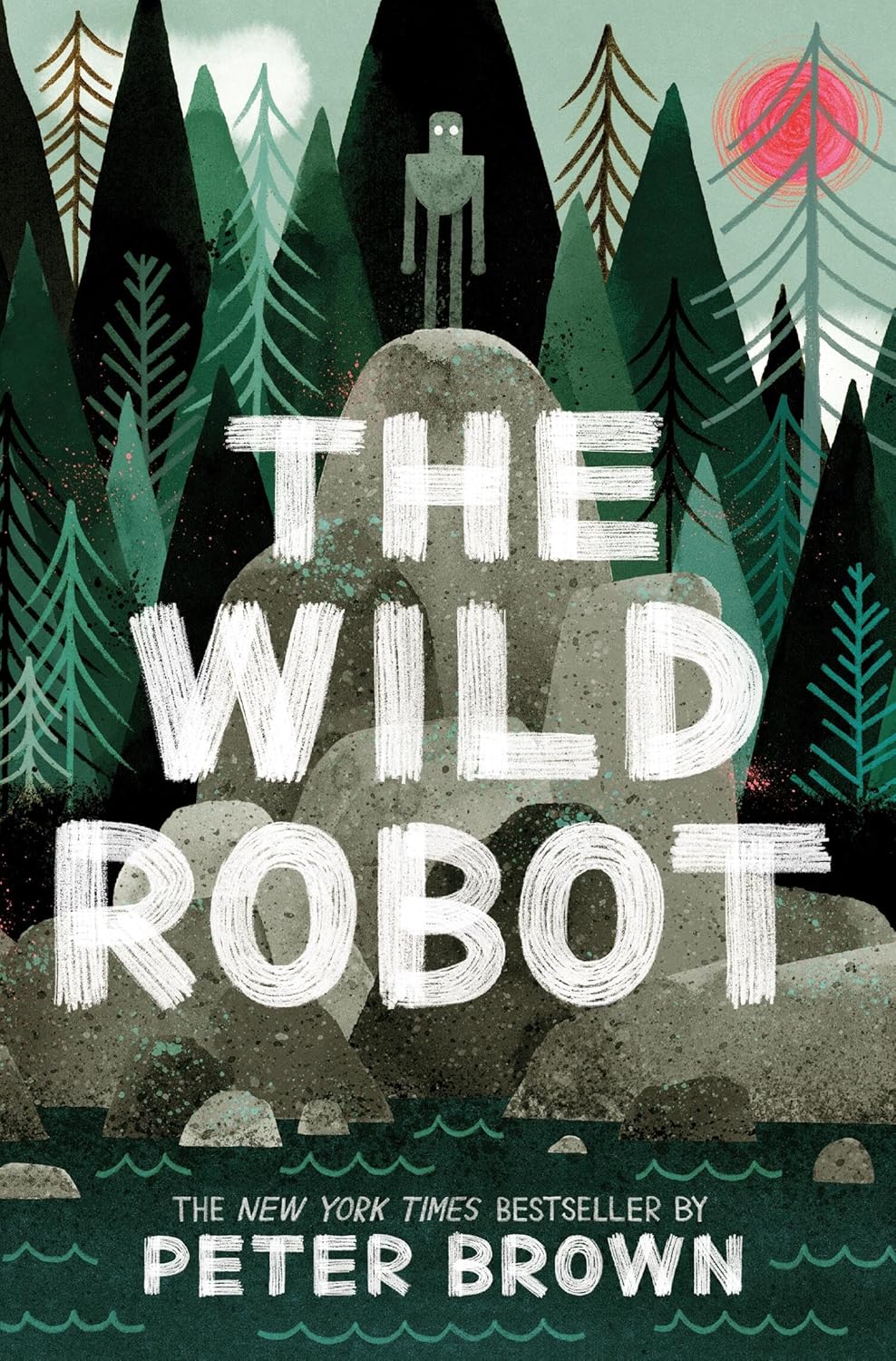Book Summary
In The Wild Robot, award-winning author-illustrator Peter Brown crafts a unique middle-grade novel about ROZZUM unit 7134 – “Roz” – who awakens on a remote island after a shipwreck. With no memory of her past, this service robot must adapt to survive in the wilderness, learning animal languages and facing hostility from the island’s inhabitants . The story takes an emotional turn when Roz accidentally orphans a gosling and becomes its adoptive mother, forming an unlikely family that challenges her robotic programming and the animals’ prejudices.
Brown’s narrative balances whimsy with profound themes, using simple yet evocative prose that works beautifully for read-aloud sessions (perfect for classrooms and bedtime) :cite[8]. The black-and-white illustrations enhance the story’s charm, though some readers wish for color given Brown’s celebrated artistic style . While comparisons to Hatchet and survival stories are apt, Roz’s journey stands out for its exploration of artificial intelligence in nature – a premise that feels increasingly relevant in our tech-driven world.
Key Themes
The novel powerfully explores nature versus technology through Roz’s transformation from a domestic robot to a wild creature. Brown avoids simplistic moralizing, instead showing how Roz’s programming evolves through her relationships, particularly with Brightbill the gosling . This mirrors real debates about AI’s role in society while remaining accessible to young readers. The island setting becomes a microcosm for ecological balance, where death and predation are presented matter-of-factly (“The wilderness really can be ugly sometimes”) yet lead to renewal .
At its core, the book is a celebration of unconventional families. Roz’s maternal journey – from her hesitant “I do not have the programming to be a mother” to fierce devotion – resonates with adoptive families and anyone who’s loved beyond biological ties . Brown also tackles bullying (animals reject Roz as a “monster”), disability (Brightbill’s wing injury), and community building as Roz helps establish an animal truce . These themes gain depth through the robot’s analytical yet increasingly emotional perspective.
What Makes It Unique
The Wild Robot stands out in children’s literature for its authentic robot protagonist. Unlike most “robot learns emotions” stories, Roz’s development feels earned through practical survival needs rather than magical anthropomorphism . Her logical problem-solving (like studying animal behavior to decode their language) makes her robotic nature integral to the plot, while her growing attachment to Brightbill subtly challenges what “programming” really means .
Brown’s background as a picture book author (Creepy Carrots!, Mr. Tiger Goes Wild) shines in the novel’s structure. Short chapters with cliffhangers maintain momentum, while the occasional narrator interjections (“As you might know, robots don’t really feel emotions…”) create a storytelling intimacy . The sequel setup feels organic rather than forced, though some critics note the final act’s RECO robots introduce conventional conflict where the wilderness itself provided ample drama .
Reader Reactions
Readers across generations praise the book’s emotional impact. Goodreads reviewers call it “one of the best middle-grade novels” with 45% giving 5 stars, highlighting how it “brought me back to my childhood” while tackling mature themes . Parents appreciate its handling of difficult topics like death, with one noting: “Brown doesn’t sugarcoat nature’s cruelty but shows how it leads to beauty – my kids understood this better than through any textbook” . The audiobook, narrated by Kate Atwater, receives particular acclaim for bringing Roz’s mechanical yet endearing voice to life .
Some critiques focus on pacing, with the first third feeling slow as Roz adapts to the island, while the RECO robot confrontation divides readers (some find it exciting, others too abrupt). Teachers report the novel sparks excellent classroom discussions about robotics, ecology, and parenting, though recommend it for grades 3-5 rather than the publisher’s suggested 7-10 age range due to its emotional complexity . Despite minor quibbles, most agree it’s a modern classic that “should be in every school library” .
About the Author
Peter Brown is a Caldecott Honor-winning author/illustrator known for blending whimsy with profound themes. A New Jersey native, he studied at Art Center College of Design before breaking into children’s books with Flight of the Dodo . His works often explore wildness vs. civilization (Mr. Tiger Goes Wild), making The Wild Robot a natural progression into longer narratives . Brown spent years researching robotics and animal behavior for this debut novel, which became a New York Times bestseller and inspired DreamWorks’ acclaimed 2024 adaptation .
Brown’s illustration background informs the novel’s visual storytelling – from Roz’s Miyazaki-esque design (glowing eyes, flower-covered body) to action sequences that play like animated scenes . He’s stated the story was partly inspired by wondering how technology could coexist peacefully with nature, contrasting typical “robot uprising” narratives :cite[9]. This optimism, combined with his honest portrayal of wilderness survival, creates a unique voice in children’s sci-fi that has earned comparisons to The Iron Giant and classic survival stories .
Memorable Quotes
“As you might know, robots don’t really feel emotions. Not the way animals do. And yet…”
— The recurring motif capturing Roz’s evolving consciousness “The wilderness really can be ugly sometimes. But from that ugliness came beauty.”
— Roz’s observation about winter’s toll, embodying the book’s balanced view of nature “I’ll tell you what: If I could do it all over again, I’d spend more time helping others.”
— Roz’s life lesson, highlighting the story’s emphasis on community
Where to Buy
The Wild Robot is available in multiple formats:
